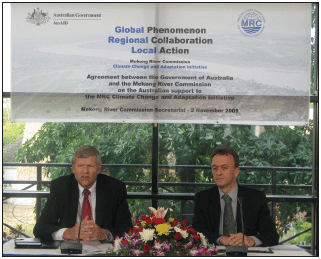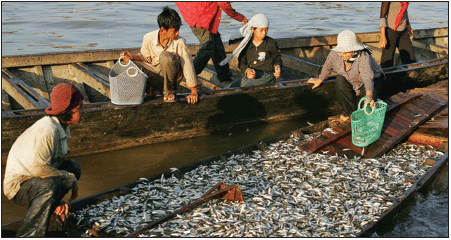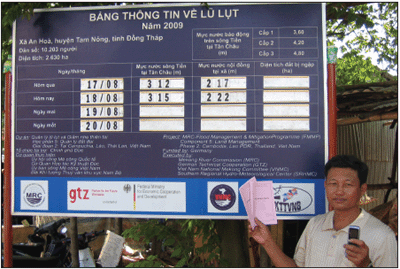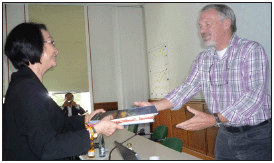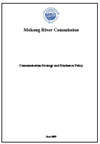In this issue:
- Mekong Ministers discuss water issues at meetings in Hua Hin, Thailand
- MRC to have two permanent offices - Phnom Penh and Vientiane
- Mekong-wide approach to understanding and acting on climate change
- Communities should have more say in river development
- Mekong-USA Cooperation on Mekong water resources challenges
- Your views sought on 11 proposed mainstream dams
- China re-affirms commitment to Mekong/Lancang cooperation and sharing information
- Overview of the 2009 flood season
- At risk villagers trained to help to report floods
- High-Level Decision-Makers visit basins in North-Western Europe
- Stockholm World Water Week 2009
- Upcoming Events
- Information Products
Subscribe/Unsubscribe
to Mekong News
Previous issues are also available online
Contact Enquiries about Mekong News can be sent to the Communications Officer:Email: mrcs@mrcmekong.org
Website: www.mrcmekong.org
Mekong Ministers discuss water issues at meetings in Hua Hin, Thailand
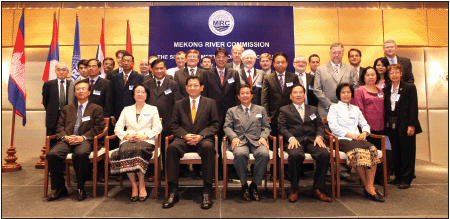
High level delegation from four MRC
Member Countries, Dialogue Partners and
Development Partners at the annual Council Meeting to discuss
water resource issues.
Photo: MRC
Environmental security is high on the agenda for all the Mekong countries as emphasised by H.E Mr. Suwit Khunkitti, the Chairperson of the MRC Council for 2009-2010 in his address to the annual meeting of the MRC Council in late November in Hua Hin, Thailand. He stressed the need for the holistic approach of Integrated Water Resources Management (IWRM) together with concerted action on a range of global environmental issues.
"We all stand to lose if we do nothing to adapt to and mitigate the threat of climate change or develop water resources infrastructure without ensuring that the extensive use of existing benefits of the river such as fisheries are protected. Likewise, we all collectively stand to gain from the sustainable use of water resources. The key principle here is that sustainability cannot be achieved without cooperation between Member Countries," he said.
The Chairperson of the MRC Council for 2009-2010 embraced an approach that looks at a wide spectrum of different functions and utilisation of water together with a broader consultation of stakeholders.
Cambodia, Lao PDR, Thailand and Viet Nam are working together on a basin-wide "IWRM" strategy to manage irrigation, hydropower and other aspects of water-use over the coming years.
The MRC Council meeting was an opportunity for the four Member Countries to share views and discuss the future direction of the river basin and how they can assist each other in addressing the challenges posed by increasing pressures on water resources of the Mekong Basin, such as hydropower, climate change, fisheries and flood management.
The Ministers also discussed the potential impact on the environment, fisheries and people’s livelihoods of eleven hydropower dams that are proposed on the mainstream Mekong and how the Member Countries can work to balance these impacts against their economic and poverty alleviation priorities.
The MRC has recently begun a Strategic Environmental Assessment into these proposals and the Government of China has agreed to take part in this study, which will give a full picture of the consequences of hydropower development in the basin (for more information, see pages 4 and 5).
MRC to have two permanent offices - Phnom Penh and Vientiane
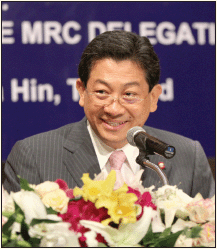
H.E. Mr. Suwit Khunkitti says effectiveness,
efficiency and sustainability are very
important for the future organisational
structure of the Secretariat.
Photo: MRC
Efficiency, effectiveness and sustainability formed the basis of a recent major decision by the MRC Council not to move its current Secretariat every five years and to set up two permanent home bases on in Phnom Penh and the other in Vientiane. "The practical reality of moving every five years according to the earlier agreement has proved to be a logistical challenge for the Secretariat. Besides the cost implications of moving, there is a disruption to the work programme, human resources and challenges for the strategic direction of the organisation," said Chairperson of the MRC Council for 2009/2010, H.E. Mr. Suwit Khunkitti, addressing the meeting in late November in Hua Hin, Thailand. "The Council of Ministers' decision on the future organisational structure of the Secretariat reflects the willingness of the MRC Council to settle the question of the location of MRCS as required under its 1995 Mekong Agreement and to concentrate on the key development opportunities and challenges facing the basin," he added.
The Office of the Chief Executive, administrative units and planning programmes will remain in the current location in Vientiane, while two Divisons will be permanently located in both Phnom Penh and Vientiane.
The Secretariat of the MRC, which will spend over US$ 80 million in riparian countries over the next four years, and currently employs more than 150 people from the four MRC countries and overseas, was due to move in its entirety to Phnom Penh in 2010 as part of a deal struck in 1996 to rotate the location of the Secretariat every five years.
Government ministers from the MRC Member Countries Cambodia, Lao PDR, Thailand and of Viet Nam made the decision on a permanent co-hosted location following months of negotiations. The move of the nominated programmes (Agriculture and Irrigation, Fisheries, Navigation, and Information and Knowledge Management) will take place progressively from June 2010 and be complete before the end of the year.
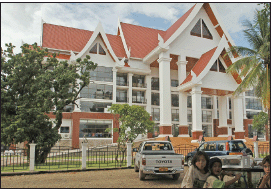 |
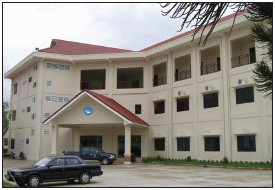 |
|
| Office of the Secretariat in Vientiane.
Photo: MRC |
Office of the Secretariat in Phnom
Penh. Photo: MRC |
Mekong-wide approach to understanding and acting on climate change
Jeremy Bird, CEO of the MRC Secretariat
and Richard Moore,
Deputy-Director General of AusAID Asia Division talk to
reporters at the launching ceremony of the CCAI.
Photo: MRC
The Mekong River Commission (MRC) announced in early November a new effort to address climate change in the Mekong Basin.
The Mekong Climate Change and Adaptation Initiative (CCAI) aims to develop and implement climate change adaptation strategies to deal with the consequences across the basin of an increase in the mean temperature, potentially higher rainfall and more frequent flooding in some parts of the basin, more drought in other parts, and a sea level rise impacting the delta.
The launching of the Mekong CCAI is the second step in a climate change partnership between Australia and the MRC. The first step focused on estimating likely changes in temperature, rainfall and river flows based on 'downscaling' global predictions of climate change. "The early support of Australia for our climate change adaptation work is very significant. It is enabling the MRC to make important progress," said Dr. Pornsook Chongprasith, Director of the MRC's Environment Division.
According to Dr. Pornsook, the Australian Government has provided grants of USD 3.5 million for the design and early implementation of the Mekong CCAI. A total budget for the CCAI through to 2015 is USD 15 million. The Mekong CCAI is part of a broader partnership between the MRC and the Australian Government.
Since 2007 Australia has pledged AUD 20 million to the MRC to support a range of activities including development of trans-boundary water resources professionals, the regional IWRM project on water utilisation negotiations, navigation, basin development planning, and the establishment of an improved MRC system for monitoring and evaluation of projects and programmes.
"The goal of the Australian Mekong Water Resources Programme is to promote regional cooperation to reduce poverty and achieve sustainable development through efficient use and management of the water resources of the Mekong Region," said Richard Moore, Deputy-Director General of AusAID Asia Division at the Mekong CCAI signing ceremony.
"We see the Mekong CCAI as a welcome new initiative that we are pleased to be supporting."
Communities should have more say in river development

Governments, donors, community representatives and developers
at
the 2nd regional meeting.
Photo: MRC
Villagers who live on or near water resources in the Mekong Basin should be given more of a voice in the planning of future infrastructure and other water development projects says the Mekong River Commission (MRC).
At a regional meeting of water management organisations and river based community leaders in October in Chiang Rai, Thailand, Jeremy Bird, CEO of the MRC Secretariat said that water has the potential for economic development.
He added, however, that views of stakeholders need to be reflected; poor and marginalised groups included in the decision-making process so they can articulate their own objectives and development paths to meet them if governments are to balance hydropower; fisheries; irrigation; navigation; and flood management in the Lower Mekong Basin.
Several groups at the meeting echoed the need for a more open process, such as Thailand's Sustainable Agriculture Network who said the forum like this should get together affected people to join and think together with all stakeholders including developers.
"A lot of forums are for governments, donors, NGOs and developers who come with different interests. We should listen more to affected people," said Laothai Nilnuan, a river based activist from the Network.
The MRC said the 2nd regional forum brought together community representatives and river based communities, but their views should be voiced more.
Suparerk Janprasart, a sociologist for the MRC said when the economic interests of one group take too much precedence over the interests of other less powerful people, the environment, livelihoods and the ecology suffer. It is only by working to engage with communities and other stakeholders that we can ensure the potential impacts are assessed and that the benefits resulting from any water resource development in the Mekong Basin are fairly redistributed to affected people.
The meeting was a forum for a number of NGOs, government agencies and human rights groups to voice their concerns over the 11 hydropower schemes planned for development on the river, over the value of biodiversity and rights of the affected people. Developers, donors and governments to explain why governments of the region are seriously considering building dams as part of their development planning.
"The problems related to dams or climate change are human-made. It is not that affected people alone who need to adapt to the climate change, such as living with floods," said Director Pham Quang Tu of Consultancy on Development from Hanoi. "All must take responsibility. Governments, NGOs, researchers, donors, developers come together to a dialogue. And the MRC facilitates," he added.
Mekong-USA Cooperation on Mekong water resources challenges
The Mekong River Commission and Mississipi River Commission announced in July their intention to cooperate on a wide range of water resources challenges common to both river basins.
The two bodies said the intention to cooperate followed the recent visit by US Secretary of State Hillary Clinton to the meeting of Mekong Foreign Ministers in Phuket, Thailand to encourage cooperation between America, ASEAN and the Mekong countries.
The two river-basin management organisations intend to exchange technical cooperation and know-how including the determination of how best to adapt to climate change as it affects the Mekong river system. They will also work together to promote the sustainability of hydropower development, address water and food security, manage and cope with floods and droughts better, and increase navigation and trade on their inland waterways in Lower Mekong Basin countries.
"Both organisations strive to manage water resources sustainably against challenges related to climate change, extreme floods, hydropower development, increasing demand for water, improving navigation and trade, and involving people in the basin more on decisions that affect their lives," said Jeremy Bird, CEO of the MRC Secretariat.
He added both organisations are therefore well-placed to benefit each other through a technical exchange and learn how to best manage their respective complex trans-boundary rivers, while Brigadier General Michael J Walsh, President of the Mississippi River Commission, believed that the two Commissions have considerable institutional and professional expertise in dealing with the challenges.
The two river commissions are currently exploring a formal agreement, which will identify a plan of action and specific institutional mechanisms for cooperation in their mutual areas of interest.
Your views sought on 11 proposed mainstream dams
60 million people depend on the Mekong
River for their livelihoods. The MRC
Strategic Environmental Assessment (SEA) studies the opportunities
and
associated risks of the dams proposed on the mainstream.
Photo: MRC
The Mekong River Commission (MRC) has established a webpage to allow members of the public to make submissions regarding the 11 hydropower schemes proposed for construction in Lao PDR, Cambodia and Thailand along the mainstream Mekong.
The public submissions, which can be made at http://www.mrcmekong. org/ish/hydro-submit.asp or by post or fax, have provided inputs to the MRC’s Strategic Environmental Assessment (SEA) that is looking at the wider economic, social and environmental implications of the proposed dams. MRC Member Countries will use the information presented by the study to guide their decisions on projects proposed on the mainstream.
Jeremy Bird, CEO of the MRC Secretariat said Mekong governments (including Cambodia, Lao PDR, Thailand and Viet Nam) have expressed "a strong desire" to understand the "full range of opportunities and risks" of any proposed mainstream hydropower project, particularly those of a regional nature, before a decision is taken to proceed.
"In order to do this effectively, it is important to have a broad consultation process that allows us to hear the views of communities, NGOs, researchers and businesses. These web page submissions provide one of the tools to help achieve this," he added.
As set out in the 1995 Mekong Agreement, MRC Member Countries must undergo a formal intergovernmental consultation process prior to building any dams on the mainstream river. Projects proposed for development on the mainstream in the lower Mekong Basin will come to the Commission for prior consultation, with a view to assisting Member Countries to reach consensus.
Although consultations have been ongoing, the webpage would help strengthen the body's Strategic Environmental Assessment (SEA), a basin-wide assessment that helps guide the countries' approach to dams proposed for the Mekong mainstream, according to Damian Kean, Communication Advisor of the MRC.
Tentative
Schedule of SEA meetings |
|
| Scoping Stage | June-October 2009 |
| • National governments and civil society meetings | |
| Baseline Assessment Stage | October-January 2010 |
| • Regional baseline workshop | |
| Risk Assessment Stage | February-April 2010 |
| • Regional multi-stakeholder workshop | |
| Mitigation Assessment Stage | June 2010 |
| • Regional mitigation workshop | |
"The idea is to get public submissions so that there is a broader scope to the SEA," he said, adding that this is the first time such a direct line to the public has been opened. Submissions will be accepted until end March 2010.
Environmental groups said the call for direct public input was a positive step.
"The MRC's SEA could potentially contribute to a deeper scientific understanding on the likely costs and benefits of the mainstream dams," said Carl Middleton, Mekong Programme Coordinator at International Rivers.
Past studies have shown that the development of hydropower can be both positive and negative, for example, the electricity generated and foreign exchange earnings can support a country's development programmes.
"However, a major concern is the effects that proposed dams could have on fish migration and numbers, and ultimately – on the people that live in the river system and who rely on fish for their livelihoods and protein intake", says Xaypladeth Choulamany, Fisheries Programme Coordinator at the MRC.
"What we need to do is to fully understand the basin wide implications of this and other impacts," he added.
Please go to the MRC website: http://www.mrcmekong.org/ISH/hydro-submit.asp to make your views known and submit any related information.
China re-affirms commitment to Mekong/Lancang cooperation and sharing information
China reaffirmed its commitment to work with MRC and its Member Countries on a range of Mekong issues including understanding of the environmental effects of hydropower dams on the river at the Mekong River Commission-run Dialogue Meeting in late July.
The Chinese delegation to the meeting presented detailed progress of hydropower schemes in the Upper Mekong and emphasised that Chinese plans to build dams have taken seriously the environmental, navigational and water-use needs of downstream riparian countries.
"The Chinese government agencies have developed strict procedures for environmental assessment," stated Chief Engineer Pen Cheng, of Hydro China. He said that much research has been conducted on the Xiaowan Dam, referring to the second largest of eight planned dams in the Lancang cascade, which has been impounding water since the start of July 2009. He added that, the scheme is reducing any impacts of impoundment as much as possible.
China is also willing to provide experts to the Strategic Environmental Assessment (SEA) that the MRC is carrying out on the 11 proposed mainstream dams in the Lower Mekong Basin (See page 4). Part of this assessment includes the development of design guidance for developers so that they make proposals to minimise or mitigate environmental problems. The detail of this guidance is available to developers in November (See http://www.mrcmekong.org/ISH/design-guidance.htm).
The Chinese delegation made other presentations on Mekong/Lancang navigation and water resource use and agreed to provide hydrological data to contribute to the MRC's flood warning system. It renewed its commitment to supply real-time hydrological data from the upstream Jinghong and Man' An monitoring stations during flood season.
Referring to an agreement made in 2008 to provide hydrological information about the Lancang/Mekong River in the flood season between the MRC and the Chinese Ministry of Water Resources, Mr. Diao Mingsheng, Head of the Chinese Delegation said "In implementing the Agreement, China will continue to provide assistance to the Lower Basin countries to guard against floods."
An MRC expert said at the meeting that the sharp rise in Mekong water level in Vientiane in early July 2009 was not caused by upstream dams, but by high rainfall in tributary watersheds. The water level in the mainstream in Vientiane rose from 2.16 meters to 9.23 metres, in just seven days as a result of this natural event.
"It is clear that Chinese dams were not a major contributor to the rapid rise in water levels in Vientiane this year. Such events like this highlight the need to share further information with both Member Countries and our upstream neighbours to better understand the hydrology of the basin," said Jeremy Bird, CEO of the Mekong River Commission. "We need to establish more hydrometeorological stations to get better information about rainfall and water levels, and I look forward to discussing with both China and Myanmar as to how we can make this happen," he added.
Overview of the 2009 flood season
The flood situation along the mainstream river was not extreme for 2009. However, in Vientiane and further north there were unusually rapid water level rises, with a 6.5 meter rise in 7 days, in the first week of July 2009. These were due to natural events.
Certain tributaries suffered considerable flash floods and associated loss of life and damage from Typhoon Ketsana, which killed over 190 people in Viet Nam, Cambodia and Lao PDR and more than US$ 800 million worth of damage caused to property. Flooding was especially high in the Mekong tributaries in Kon Tum Province in Viet Nam, Kampong Thom Province in Cambodia and Attapeu Province in Lao PDR, where thousands were displaced and emergency humanitarian assistance is still required.
In addition to providing relief support through its Navigation Programme, the MRC is developing a flash flood guidance system on the Mekong tributaries to guide the dissemination of information about possible flash floods through the National Forecasting Centres, who will determine whether or not to issue warnings, with support and guidance from the MRC Regional Flood Management and Mitigation Centre (RFMMC) in Phnom Penh.
With over 30 hydro-meteorological stations established on tributaries, the system is expected to be fully tested and online in 2010. It will provide automatic real-time information about rainfall and water levels to assess the potential of flash floods, thereby allowing improvement of the early warning system and faster mobilisation of response agencies. The information will be updated on the MRC website every 15 minutes.
At risk villagers trained to help to report floods
Villagers can send text message of
water levels and publicise recorded
flood forecast figures on MRC provided billboards at central
locations in
the floodplains.
Photo: MRC
Villagers in floodplain regions of Cambodia, Lao PDR and the Mekong Delta of Viet Nam have been provided with cell phones and trained to use them as part of a flood warning system by recording water levels in remote areas and reporting the figures to local weather agencies.
Fourteen villages from Cambodia, seven villages from Viet Nam and 19 villages from Lao PDR were provided with 35 phones, 80 flood markers and other equipment and training as observers to take wet-season water level measurements of the likelihood of local flooding and send these to the national agencies responsible for flood forecasting and warnings.
The scheme, supported by the Mekong River Commission (MRC), is part of a regional trial to increase the level of involvement in the flood forecasting process for communities living on vulnerable flood plains and to boost the capacity of national flood forecasting agencies. It followed the devastating flood in 2008 which saw US$ 135 million worth of damage when rivers in the Lower Mekong Basin reached their highest levels since 1966.
"Villagers take measurements twice a day, from newly established flood markers in the floodplains and then report these figures via text messages," said Hatda An Pich, Operations Manager of the MRC’s Regional Flood Management and Mitigation Centre (RFMMC) based in Phnom Penh, which is responsible for flood forecasting on the mainstream of the Mekong.
The government hydrology agency in each country records the text messages in a computer, converts them into flood forecast figures and sends these back to villagers. The villagers then publicise the figures on MRC provided billboards at central locations in the flood plains – and advertise any imminent flood threat via loudspeakers.
The village-based flood monitoring on the floodplains now complements and contributes to the regional flood forecast that the MRC produces daily in the wet season, based on information collected at stations on the mainstream of the Mekong. The national agencies are able to make a computerised comparison with the flood situation on the mainstream. The MRC says that the two different data sets will offer greater accuracy and therefore more precise flood warnings to communities.
The training and equipment allocated to villages, including boats, bikes, petrol for motorcycles, measuring equipment and notice boards for the villages, is part of on-going MRC supported efforts to improve the capacity of national agency flood forecasting on Mekong basin tributaries.
"The MRC is investing significant time and resources into improving short to medium term flood forecasts," said Dr. Lam Hung Son, Flood Management and Mitigation Programme Coordinator. "Involving villagers themselves in this process is part of the efforts to increase the accuracy of flood forecasts on tributaries and between the main flood monitoring stations on the mainstream," he added.
High-Level Decision-Makers visit basins in North-Western Europe
H.E Mme. Khempheng Pholsena, Member
of MRC
Council for Lao PDR, hands over MRC information
to the Secretary General of the Rhine Commission,
Ir. Ben van de Wetering.
Photo: MRC
Under MRC Flood Management and Mitigation Programme (FMMP)’s component entitled “Enhancing Cooperation in Addressing Transboundary Flood Issues,” an exchange study visit with support from UESCOIHE, Delft on behalf of FMMP was organised in September for MRC high-level decision makers to study transboundary river basin and flood management in North-Western Europe.
The delegation started their visit at the UNESCO-IHE institute in Delft, the Netherlands and travelled to the Border Meuse region between Belgium and the Netherlands. The delegation learned about water and flood management in the Netherlands and the cooperation in the European context as well as the different perspectives of Belgium and the Netherlands in basin management over time were illustrated. The major aspects covered were the mandates and institutional structures of the Meuse and Rhine Commissions working with the European Water Framework Directive, the implementation of joint planning of basin-wide flood risk reduction projects, as well as the building of confidence and trust through implementation of transboundary pilot projects.

The MRC delegation after visiting
UNESCO-IHE in Delft.
Photo: MRC
Discussions took place on basin cooperation and development of cooperation over time and particularly focused on the Rhine Commission as a possible future institutionalised model for MRC’s working arrangement.
The delegation participated in a mini-seminar at the headquarters of the Dutch Ministry of Transport, Public Works and Water Management in The Hague, where best practices in transboundary cooperation were shared and discussed. Finally a visit to the Dutch coastal defence system including the world famous Delta Works was also incorporated.
Stockholm World Water Week 2009
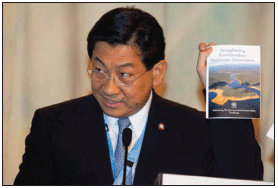
H.E Suwit Khunkitti, MRC Council
Chairperson
2009-2010, says trust building is essential to effective
transboundary water cooperation.
Photo: Thomas Henrikson
The Stockholm Water Week in August has earned international recognition. The prominent meeting of about 2,000 people with an interest in water, is an excellent networking opportunity. A central theme underlying the discussions was transboundary water resources management, which is of particular relevance to MRC.
H.E. Suwit Khunkitti, the Chairperson of the MRC Council gave a keynote speech in a seminar entitled 'Structured Approaches to Realise Benefits for All.' In the daily Water Week Newsletter the Minister was quoted as praising the long-standing role of the Mekong River Commission in helping its riparian states to attain equitable benefit sharing for all its members, and argued that "cooperation and trust are the most important factors for sharing the benefits of transboundary rivers."
H.E. Mme Khempheng Pholsena, MRC Council Member of Lao PDR took a prominent role in a High Level Panel discussion on Transboundary Waters and used the experience from the Mekong region to promote collaboration on international rivers to reach a peaceful and mutually beneficial solution to water sharing.
Mr. Jeremy, CEO of the MRC Secretariat, made a presentation entitled "Mekong Basin – a meeting of two different worlds," focusing on the Mekong's water resources and MRC's role in facilitating dialogue between upstream and downstream countries; dialogue about the need for water resources and the need for energy resources as well as the role in maintaining productive fisheries, monitoring water flow, water quality, sediment, salinity and promoting navigation.
Upcoming events
15-Year Anniversary of MRC, 5 April 2010, Khon Kaen, Thailand
The MRC Summit will bring together Prime Ministers from Cambodia; Lao PDR; Thailand; and Viet Nam, the Dialogue Partners China and Myanmar as well as representatives of regional bodies and other governments to celebrate the 15 year anniversary of the MRC in Khon Kaen, Thailand.
The celebration aims to reaffirm at the highest level the political commitment of Member Countries to the successful implementation of the Mekong Agreement and the continued relevance of the MRC in the changing development context; to provide a vision for the organisation for the next 15 – 20 years; to strengthen the MRC’s working relationship with China and Myanmar; to increase cooperation between the MRC and the GMS; to increase cooperation between the MRC, the ADB and the World Bank; and to increase cooperation between the MRC and ASEAN.
8th Annual Mekong Flood Forum, 26-27 May 2010, Vientiane, Lao PDR
The Forum aims to raise awareness on the current state of flood
risk management and mitigation at the national, regional and
community levels in the Mekong River Basin and to exchange information
on the progress, achievements and future outlook with respect
to the five components of the Flood Management and Mitigation
Programme (FMMP). Details of upcoming events can be found at
http://www.mrcmekong.org/
MRC_news/all_events.htm
Information Products
Catch & Culture 15, No.3, December 2009 contains: •Modelling dam impacts on migratory species Free download: http://www.mrcmekong.org/free_download/research.htm#tech
|
|
|
|
||
In Brief
Communication Strategy and Disclosure Policy The MRC Communication Strategy and The Communication Strategy seeks The Disclosure Policy allows the MRC For details of the Communication |
Living Mekong sheds light on river life
As a book that draws on research by MRC and WWF about fisheries and the environment, the Living Mekong, shows how the Mekong’s seasonal rise and fall shapes daily life for the people who live on and around it, in matters from transport to festivals and to fish trap design. By world standards, the Mekong fishery is immense in scale, producing around 2.5 million tons of wild fish a year, or roughly two percent of the entire world catch (including freshwater and marine). In numbers of fish species, the Mekong is second only to the Amazon. This unique collection of photographs takes us beyond the familiar postcard views of the Mekong to sites rarely seen by the public; from secluded natural pools known only to local fishers, to factory floors that package the fillets appearing on restaurant platters all over the world. Aerial images, captured from helicopters, show habitats that are critical to the survival of many species. The book was authored by WWF and MRC and is published by Silkworm Books. The book is available through Silkworm Books at: http://www.silkwormbooks. com/each_titles/e_sea/2009/living-mekong.html |
|
| How to order | Contact | |
| Most publications can be ordered from the MRC Secretariat’s
Documentation Centre or downloaded from www.mrcmekong.org. Postage costs may apply for hard copies. |
Documentation Centre Mekong River Commission Secretariat
P.O. Box 6101, 184 Fa Ngoum Road, Unit 18, Ban Sithane Neua,
Sikhottabong District, Vientiane 01000, Lao PDR Open: Mon-Fri, 8:30 - 12:00, 13:30-16:30 Phone: (856 21) 263 263 ext: 1041 Fax: (856 21) 263 264 Email: doc.centre@mrcmekong.org Website: www.mrcmekong.org |
|
| For access to the latest reports and research on development issues, visit www.mekonginfo.org | ||
Choose a newsletter:

